Samsung Chromebook (XE303) Review: Testing ARM's Cortex A15
by Anand Lal Shimpi on October 31, 2012 9:00 AM ESTInside the new Chromebook
Similar to its predecessors, getting access to the internals of the new Chromebook doesn't require anything more than a tiny Phillips head screwdriver. There are four exposed screws and four more under the feet beneath the chassis. Remove all eight screws and you can pry off the bottom cover. The cover snaps into place so be careful if/when you remove it.
Inside the new Chromebook is a far more simplified setup. It honestly looks more like a modern day tablet under the hood. I never got the Celeron based Chromebook 550, but I do have the 500 which featured a dual-core Atom N570 processor. Here's a shot of that model for comparison:
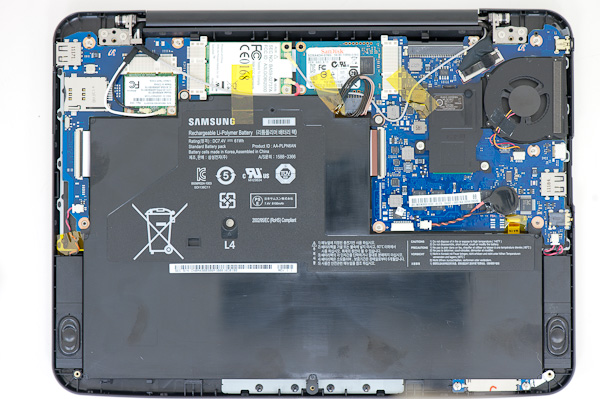
The old Atom N570 based Chromebook
Right off the bat you'll notice a significant reduction in battery capacity. That old N570 based Chromebook had a mammoth 61Wh battery compared to the more tablet-sized 30Wh battery in the new model.
The old motherboard was also far less integrated. Discrete cards were used to provide cellular and WiFi connectivity, whereas the new board integrates WiFi (Marvell?) directly onto the motherboard.
The cost reduction extends to the SoC side as well. Intel charges $86 for an Atom N570, while the going rate for high-end ARM based SoCs is in the $20 - $30 range (and this is why ARM is the new AMD when it comes to keeping Intel pricing in check). I also suspect that this first run of Samsung Exynos 5 Dual chips are a bit leakier and perhaps even lower yielding than what we'll eventually see down the road. Samsung could be motivated to move these parts at a better cost structure as they work out kinks in manufacturing.
Note that the previous Atom solution required two chips: the N570 and its NM10 Express PCH. The N570 had a 2.1W TDP and was used for all IO, while the N570 and its two Atom cores needed about 8.5W. The combination was fine for a notebook but when Haswell can deliver much better performance within the same TDP, it's clear the old 45nm CPU + chipset were getting long in the tooth.
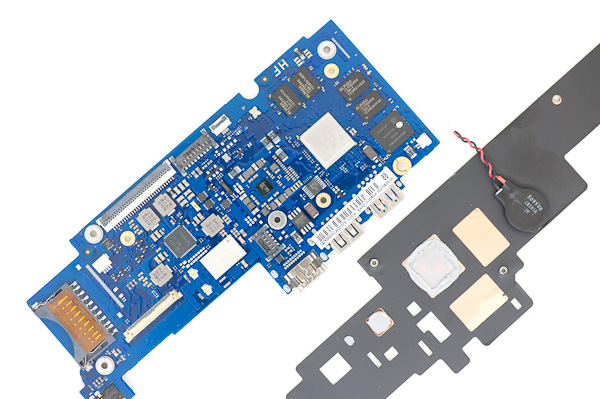
The far simplified, single-chip Samsung Exynos 5 Dual solution
Despite the absence of any significant heatsink, to remove 10.6W of heat you do need forced air convection hence the inclusion of a fan in the old Chromebook 500. The thermal requirements of the Exynos 5 Dual are significantly lower. The SoC benefits from Samsung's 32nm HK+MG LP process and is highly integrated, meaning there's only a single chip. Although there's a big heatspreader plate complete with heatpipe that runs over the Exynos 5, there's no fan needed. Removing the fan lowers build cost, reduces internal complexity, and helped Samsung shrink the chassis size.
There are a total of 8 x 256MB DDR3L devices (2GB total) that surround the Exynos 5 Dual SoC (4 on each side of the PCB). Each device is 8-bits wide, all connecting up to the 64-bit wide DDR3L memory controller. The DRAM is clocked at a 1600MHz data rate, resulting in 12.8GB/s of memory bandwidth to the chip. The Exynos 5 Dual integrates two ARM Cortex A15 CPU cores as well as an ARM Mali-T604 GPU.

The other big change on the motherboard is the move from a SanDisk discrete controller + NAND device to an integrated iNAND solution for storage. Capacity remains unchanged at 16GB, but the integrated eMMC controller does offer board (and perhaps cost) savings.
Moving to a lower power SoC not only gave Samsung some flexiblity in cooling, it also allowed it to run the platform with a much smaller battery. While the old Chromebook 500 used a massive 61Wh battery, the new model only needs a 30Wh unit. Battery life has gone down (Exynos 5 Dual isn't 2x more power efficient than the 45nm Atom N570) but so has weight as well. I believe the Chromebook 550 ditched the giant battery and moved to a ~40Wh unit, so the difference isn't as drastic there.


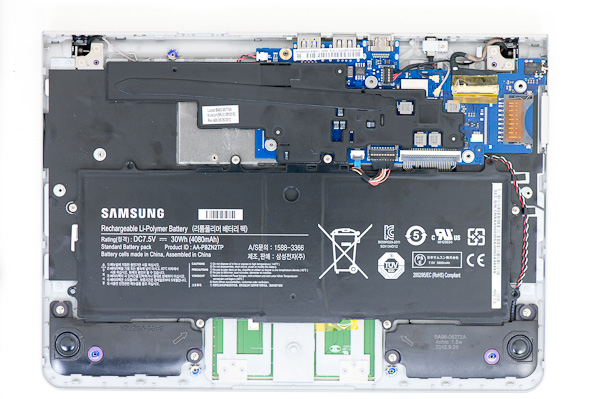
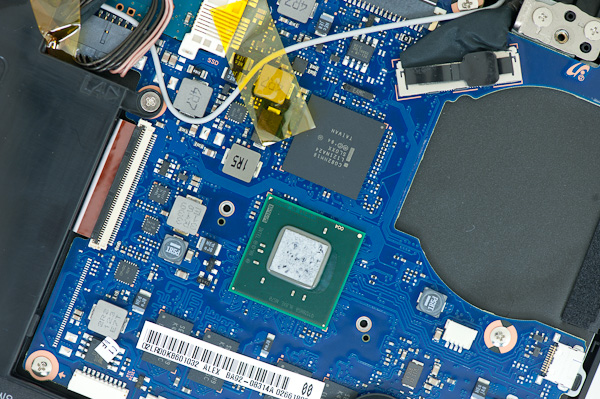
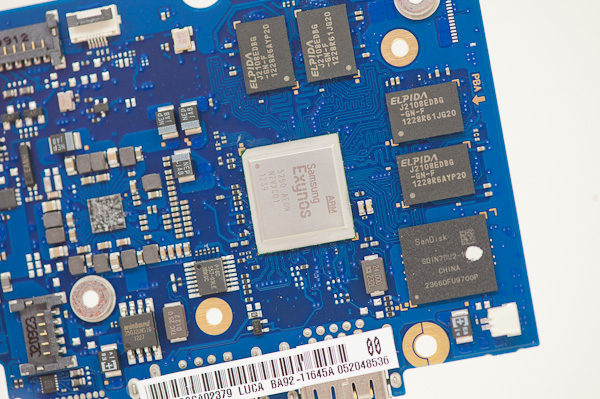
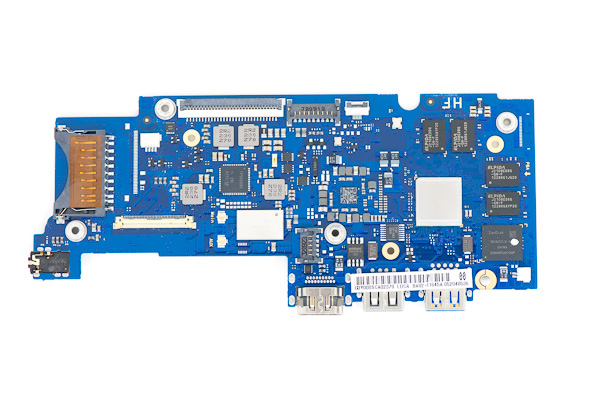














149 Comments
View All Comments
zappb - Wednesday, October 31, 2012 - link
looks awesome - between this and the Nexus 10Flunk - Wednesday, October 31, 2012 - link
I recommend the Nexus 10, better screen and OS. ChromeOS is a real turkey.quiksilvr - Wednesday, October 31, 2012 - link
It really boils down to what you need. If you can live without a keyboard, get the Nexus 10. If you are on a budget, get this. If you want a keyboard and are willing to shell extra dough, get the Nexus 10 and a bluetooth keyboard.B3an - Wednesday, October 31, 2012 - link
He wasn't talking about keyboards and form factors. Chrome OS is almost completely useless for anything more than browsing the net. It's about equivalent to a basic feature phone in capability. It's for such a small niche, about the only people i could see buying Chrome OS notebooks are extremely poor students, and even then it probably wont do everything they want.jeffkro - Wednesday, October 31, 2012 - link
Another niche market is for people that do online investing and banking with significant assets. The added security of chrome OS is well worth having for $250 you won't find much cheaper insurance. Windows is just not safe for online financial transactions, which of course the poor student doesn't have to worry about.jeffkro - Wednesday, October 31, 2012 - link
By the way I find google docs to be pretty useful for productivity. I used to use open office and since I made the switch I haven't looked back. Netflix not being supported on the ARM version is kind of a bummer though. I think Google should make sure that Hulu, Netflix, and Amazon streaming all work as this definitely fits under the umbrella of cloud computing.damianrobertjones - Thursday, November 1, 2012 - link
Windows is safe... Don't run as full admin and maybe the user might have some common sense not to visit porn sitesklmccaughey - Thursday, November 1, 2012 - link
No, they can use a Chromebook to visit porn sites or any other activity (long list) that might get them on trouble in Windows.I maintain the computers (just) in my house and home office, and for one user I really wish he had a Chromebook and not a Windows laptop - I keep having to restore it from image.
Oh and I use Windows 7 x64 as my main machine, with Ubuntu VM for development.
Wolfpup - Friday, November 2, 2012 - link
Nothing wrong with porn sites...like any other business they're not especially wanting to screw over their customers.Sabresiberian - Friday, November 2, 2012 - link
ChromeOS is NOT more secure than Windows. You are putting too much stock in anti-Microsoft blather from Google. Might as well listen to Apple's opinion of Windows.Does this SoC even have the hardware security features built into Intel and AMD x86 chips (AES, Intel Secure Key, OS Guard)? I don't think it does. ChromeOS might require different methods to crack, but it is not more secure, and the hardware of the Chromebook is less secure.
Besides, I'd imagine any successful investor is going to be using something a lot more satisfying than a tiny, cheap netbook variation with a so-so screen.